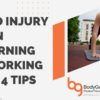 What is good posture?
What is good posture?
If you’ve ever been told to sit up straight, then you know the resulting posture is unnatural and short-lived. Often, when people are told to sit up straight, they go from one extreme to the other, holding themselves up in an army-like fashion in sharp contrast to the slouching they were doing just moments before. In reality, good posture is neutral posture. This means that your joints and muscles are comfortably resting in a mid-range position. The operative word being resting, meaning that you should not be actively holding yourself in this position. The best test to know whether or not you’re truly sitting with good posture is to completely relax. If you collapse down, then you were not in a neutral position. If you maintain your good posture while completely relaxed, then you have successfully stacked your skeleton into a neutral position that will keep you upright without any muscular effort. Because you’re not using muscular effort to maintain your good posture, you can stay there comfortably for much longer.
Why is good posture important?
Everyone knows that in general, it’s better to have good posture, but why? You might already know that good posture puts less strain on joints and muscles, but there’s another reason. What most people don’t know is that good posture is essential for effective core muscle activation. At BodyGears, we call this CoreFirst Strategies™ and we teach this to every patient we see because regardless of what brought you to the clinic, everyone needs an efficient core. You could have the strongest core muscles in the world, but if you have bad posture, those muscles won’t even turn on.
What is “Ergonomics”?
Likely you’ve heard the term “ergonomic” in the description of a chair or seen it advertised on a variety of office supplies. Perhaps you’re lucky and you have an ergonomist at your place of work. You should be aware that there is an important distinction between items described as “ergonomic” and the practice of ergonomics. There is no regulating body to determine what constitutes an “ergonomic” item. Companies are allowed to use this term as they please and could even choose to sell ergonomic potatoes. The term “ergonomic” is supposed to mean that the item is designed with the mechanics of the user as the priority rather than the aesthetic of the item. However, no product can be universally ergonomic because everyone’s body dimensions, work environments, and task requirements differs. That’s where an ergonomist or someone trained in ergonomics is needed to determine which product best suits the user in order to complete the task. Ergonomics is all about fitting the task to the person, rather than the person to the task in order to prevent injury and improve efficiency.
What happens during an ergonomic evaluation?
First, we will analyze your body dimensions and functional abilities as well as the job or task requirements. Next, the environment is assessed in-person or with photos to determine any risk for injury or areas of inefficiency when you perform the task. Recommendations will then be made to adjust the existing environment, to improve your movement and posture strategies, and to introduce or replace items within the environment as necessary.
If you have questions about anything you just read, you’ve injured yourself at work, or you want to know how to improve your posture and lower your risk of injury, Request Free Consult or Contact Us Today at Chicago, Oak Brook, & Winnetka, IL Centers to learn more about our Postural Retraining Program and to schedule an appointment. We’ll help you have the best posture for any scenario.





